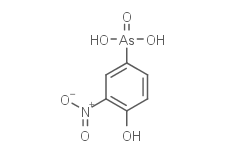
Roxarsone
CAS No. 121-19-7
Roxarsone( 3-nitro-4-hydroxyphenylarsonic acid )
Catalog No. M19504 CAS No. 121-19-7
Roxarsone is an organoarsenic compound that is widely used in poultry production as a feed additive to increase weight gain and improve feed efficiency and as a coccidiostat.
Purity : >98% (HPLC)
 COA
COA
 Datasheet
Datasheet
 HNMR
HNMR
 HPLC
HPLC
 MSDS
MSDS
 Handing Instructions
Handing Instructions
| Size | Price / USD | Stock | Quantity |
| 100MG | Get Quote | Get Quote |


|
| 200MG | Get Quote | Get Quote |


|
| 500MG | Get Quote | Get Quote |


|
| 1G | Get Quote | Get Quote |


|
Biological Information
-
Product NameRoxarsone
-
NoteResearch use only, not for human use.
-
Brief DescriptionRoxarsone is an organoarsenic compound that is widely used in poultry production as a feed additive to increase weight gain and improve feed efficiency and as a coccidiostat.
-
DescriptionRoxarsone is an organoarsenic compound that is widely used in poultry production as a feed additive to increase weight gain and improve feed efficiency and as a coccidiostat.
-
In Vitro——
-
In Vivo——
-
Synonyms3-nitro-4-hydroxyphenylarsonic acid
-
PathwayGPCR/G Protein
-
TargetAntibacterial
-
RecptorAntibacterial
-
Research AreaOthers
-
IndicationVet Drug
Chemical Information
-
CAS Number121-19-7
-
Formula Weight263.04
-
Molecular FormulaC6H6AsNO6
-
Purity>98% (HPLC)
-
SolubilityDMSO: ≥ 2.7 mg/mL (10.26 mM)
-
SMILESOC1=C(C=C(C=C1)[As](O)(O)=O)[N+]([O-])=O
-
Chemical NameBenzenearsonic acid 4-hydroxy-3-nitro-
Shipping & Storage Information
-
Storage(-20℃)
-
ShippingWith Ice Pack
-
Stability≥ 2 years
Reference
1.Huang L et al. Chemosphere. 2014 Apr;100:57-62.
molnova catalog



related products
-
F7H
F7H is a potent Frizzled receptor FZD7 antagonist with an IC50 value of 1.25 μM.F7H is a potent ligand for the transmembrane structural domain (TMD) of FZD7, with potential antitumor and bacteriostatic activity.
-
Penicillin G sodium ...
Benzylpenicillin sodium is a penicillin derivative commonly used in the form of its sodium or potassium salts in the treatment of a variety of infections.
-
Cyclo-L-Trp-L-Trp
Cyclo-L-Trp-L-Trp is a broad-spectrum antifungal. It also induces a high degree of acetylation of histones.



 Cart
Cart
 sales@molnova.com
sales@molnova.com


